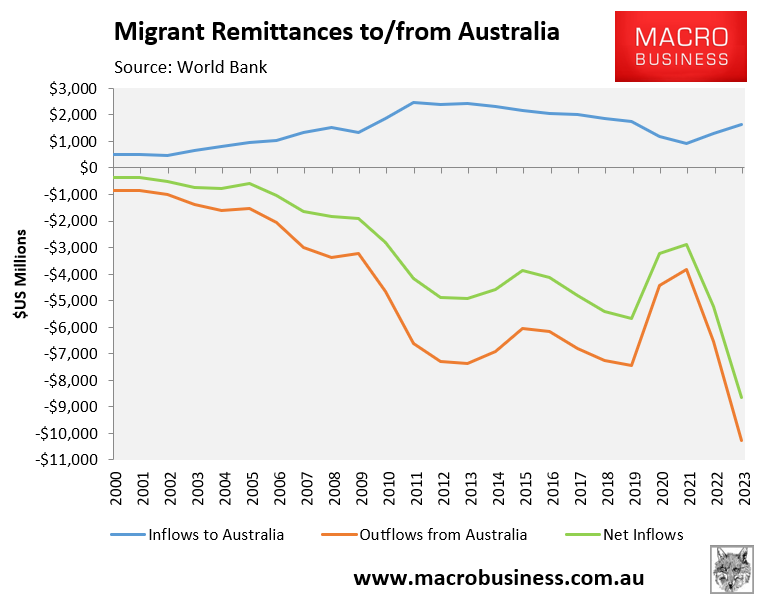For many years, MB has argued that the Australian Bureau of Statistics’ (ABS) estimate of the export of education is exaggerated because it incorrectly included income from international students working in Australia.
On Wednesday, the ABS released a paper confirming that one-quarter of the reported export figure comprises money earned in Australia and, therefore, is not an export.
However, the ABS won’t change how it reports education exports because it is an international standard.
Below is the key extract from the ABS paper:
All expenditure by international students studying in Australia is recorded as an export in the Balance of Payments statistics published by the Australian Bureau of Statistics. This includes expenditure on tuition fees, food, accommodation, local transport, health services, etc., by international students while in Australia. This expenditure contributed $50.5 billion to Australia’s exports in the 2023-24 financial year.
The classification as an export of expenditure by international students studying in Australia does not depend on how the students fund their expenditure in Australia. Some of the expenditure is funded from overseas sources. While it is not possible to be precise, ABS estimates suggest around a quarter of the expenditure (around $13 billion in the 2023-24 financial year) is funded by international students working in Australia for Australian employers.
This classification of international students’ expenditure is determined by international standards specified in the International Monetary Fund’s Balance of Payments Manual and is widely adhered to across the globe.
The $13 billion of income earned in Australia by international students is what has been “recorded in the primary income account as an outflow of income from Australia (debit entry) as Compensation of Employees”.
We know that a large share of students work off-the-books for cash. Therefore, the true amount of income earned by students in Australia would be higher (meaning exports would be lower).
I have also stated repeatedly that Australia loses significant sums of money abroad via remittance payments:

According to the World Bank, Australia sent US$8.6 billion in net remittances to other nations in 2023. A significant proportion of these remittances would likely have gone from international students working and living in Australia:

The ABS noted that remittances are not considered when measuring education exports:
“Personal transfers of cash or in-kind (sometimes referred to as workers remittances) between residents and non-residents are recorded under secondary income”.
“However, if an international student receives funds from their non-resident parents who live overseas, or if the student transfers funds back to their home economy, both of these transactions would be out of scope of Australia’s balance of payments as they are transactions between non-residents”.
The ABS also provides the following examples explaining how the current account captures international education:
Example 1:
Sam, an international student studying at an Australian university, spends $100,000 on goods and services from Australian businesses (for tuition fees, food, accommodation, transport, and so on). Sam also has a part-time job while studying in Australia and earns $20,000 in wages from an Australian employer.
The $100,000 Sam spent is an export of education-related Travel services and recorded as a ‘service export’ (credit) in the trade balance. The $20,000 Sam earnt in wages is recorded as compensation of employees debits in the primary income balance. Sam’s net impact on the Current account is $80,000.
Example 2:
An Australian university pays $10,000 to a non-resident business to advertise their courses to potential international students.
The $10,000 the Australian university spent is an import of ‘Other business services: professional and management consulting services’ and is recorded as a ‘service import’ (debit) in the trade balance. The net impact of this transaction on the Current account is -$10,000.
So basically, education exports include all expenditures by international students in Australia, whereas money earned by students and commissions paid by universities to foreign agents are netted off elsewhere in the current account. Money sent home by students is also not counted.
The bottom line is that the headline education export figure quoted by the ABS is exaggerated and should be discounted by:
- Money earned by students in Australia (both formal and informal);
- Remittances sent home; and
- Commissions paid by universities and colleges to foreign agents.
For transparency purposes, the ABS should include a footnote noting that education exports are a gross figure and do not account for income earned in Australia by students, remittance outflows, or commissions paid by universities to foreign agents.
The government, media and industry should also stop quoting this fantastical figure as fact.

